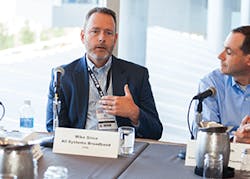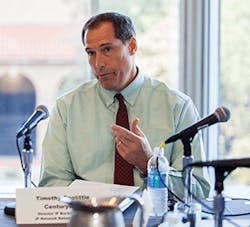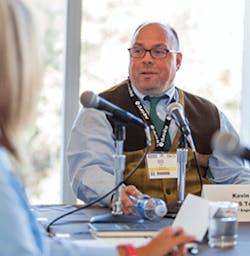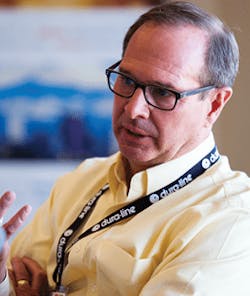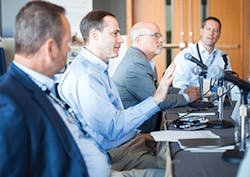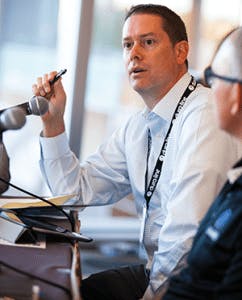ICT Professionals Discuss Critical Topics During a Live Roundtable Held at ISE EXPO 2016 in San Antonio, Texas.
Wish you were a fly on the wall during our 2016 ICT Influencers Roundtable? We can’t blame you.
At ISE EXPO 2016, 9 ICT professionals gathered to discuss many important topics facing our industry. Due to the length of the roundtable discussion, we can’t share all of those goodies, or we’d have to — you know. (Think of that canned James bond saying.) We can, however, share 3 of the topics our ICT Influencers discussed on-site at ISE EXPO 2016.
[toggle title=”The 9 participants in the Roundtable are:” load=”hide”]Mike Grice
CTO
All Systems Broadband
Sabrena Lampley-Talbert
Director Construction & Engineering
AT&T
Timothy Doolittle
Director IP Backbone NRC
IP Network Reliability Center
CenturyLink
Brian Schrand
Director of Application Engineering
Clearfield
Randy Frantz
Director, Telecommunications Solutions
Esri
Jeff Polachek
Vice President, Operations
Level 3 Communications
Kevin Maes
Manager of OSP Engineering
& Construction
TDS Telecom
Kevin Smith
Executive Director
Network Transformation
Verizon
Eric Swanson
Director of Product Management
Communications Network Solutions
Westell Technologies[/toggle]
The first topic addressed 2017 planning. The second asked our panelists What we are missing as an industry? And the third topic addressed the challenges and opportunities we face related to the IoT.
The Roundtable was co-moderated by Sharon Vollman, SVP and Editorial Director, ISE magazine and ISE EXPO, and Ernie Gallo, Director, Ericsson. These responses are edited and condensed from the original Roundtable discussion.
2017 Planning
ISE: Talk about the biggest challenges you feel providers face right now as they plan for 2017.
Lampley-Talbert, AT&T
When we’re building the network, we really want to get fiber in as many places as possible. The question is where to put it, and how can we get it there in the most cost-effective manner, which also needs to be the least disruptive manner?
Smith, Verizon
For 2017 planning, we are looking at how to effectively manage the transition from legacy to Next Gen. Two big words that come to my mind are migration and decommissioning. Carriers need to establish the appropriate thresholds regarding when to implement a cap and grow strategy as well as when to trigger migrations and decom. Effectively managing these transitions will prevent stranding capacity in legacy systems and overbuilding power and cooling systems. The goal is to focus a majority of your people and financial resources on the long-term strategic platforms.
Polachek, Level 3 Communications
More than likely the biggest challenge we’ll have going into 2017 is similar to previous years: scalability. How are we going to continue to grow in the face of a deflationary business? Our products, just like the products of everyone around this table, continue to decrease in price. We must continue to find efficiencies in the way we do business, so we can continue to turn a profit while addressing the fact that our products continue to decrease in price over time.
Frantz, Esri
I agree with my colleagues: there’s a limited amount of available capital, so your network investment must meet your customers’ needs while maximizing your ROI. The challenge is putting the right architecture in the right location at the right time. Some of that’s going to be for greenfield. Some of that’s going to be overbuild. You need to make the correct strategic decisions and then support them with near flawless tactical execution on
the local level.
Doolittle, CenturyLink
I echo what has been said so far, but I’ll add that I think there’s far more transformation going on now than at any time over the last 15-20 years. It used to be that the dominant thing we had to do every year was make the network "more and faster and bigger". Today, there’s actually a transformation occurring in how we implement all of these services related to virtualization and other things.
That’s going to drive some very tricky capital decisions as we decide How much money do we stick in this virtualization stuff? It’s not going to deliver initially anything more than we’ve got right now, but you don’t want to get behind. So, it’s a fine line to walk.
What that drives, on top of the capital decisions and some of those product decisions, is organizational challenges. We have issues where the technologies are merging together, and SDN and NFV are driving some new combinations of skill sets that don’t exist today. What does that mean? Training requirements. Organizational requirements. All of those things are really tough as we look to the next year.
Schrand, Clearfield
Going out and dealing with a lot of the non-traditional large carriers, you’ll see that their biggest challenge is workforce reduction. The Millennials are coming into the workforce, and the Boomers are retiring at a rate of 2-to-1.
When the Boomers came into the workforce it was in a twisted-pair environment. And over time, as fiber trickled in, they were able to grow with the technology. The Millennials do not have that luxury. So, we’re seeing a lot more service providers asking for plug-’n’-play products in the outside plant environment because they help alleviate that workforce reduction and also speed up installation times.
Maes, TDS Telecom
Our challenge is really around the rural side of things, because we are in the process of the Connect America Fund. And we have some extremely rural properties. For example, TDS serves the bottom of the Grand Canyon. We’re on some islands off the coast of Maine. That means, we have unique challenges from an outside plant perspective. So, it’s really finding the right combination of technologies. Where can we live with what we have there today? Where can we build fiber? And, again, being extremely rural we have to find the right mixture.
Many times we find ourselves saying, "If you do this now, it’s going to cost you this much. But likely that ‘new’ technology is going to reduce in price over time." The question is when is it time to move forward and invest?
Of course, when making decisions, service providers just can’t look at their own set of circumstances, because it isn’t a competition-free environment. Providers have new competition entering the markets they have historically owned, and they’re showing up strong. So, the incumbents must be competitive.
I see one of the big struggles is trying to figure out the new "gold standard." If I’m a service provider, do I go for the whole thing? Do I start small and migrate later to a bigger financial commitment? There are a lot of decisions to make that affect the outcome, and none of them are easy.
Swanson, Westell Technologies
I struggle with some of the same things that Brian mentioned as far as the balance between legacy and new equipment. At Westell, we still sell some of the legacy products, and we are finding as we go into our customers, a lot of their staff isn’t prepared to support it any longer; they’ve moved on to the newer stuff. So, everybody’s moved to the new technologies, but yet there’s still some older technologies that need to be addressed — and there isn’t the staff training to support it.
Overlooked Issues
ISE: What should we be talking about that we are not? What is the network side of the ICT industry we’re missing?
Polachek, Level 3
I believe the industry and our entire society is missing the critical nature of cyber security. How are we going to ensure that we protect the data our customers trust us with as providers? Our company has released products specific to this. But as we go to a more cloud-based architecture, how do we ensure that we’re consistently protecting our customers’ data, and provide the level of security for which they’re looking?
One of the issues that we must realize, even as competitors, is that when there is a denial-of-service attack … it’s unlikely that the attack is all on Level 3’s network or CenturyLink’s network, or AT&T’s network. The attackers are coming from outside in. Today, there are very few mechanisms that allow carriers to automatically connect with other carriers’ networks to say, "Hey, we know this is an attack. Can you block it on your side so it doesn’t clog our peering points or whatever the situation is?"
The other thing I woke up one day thinking about relates to transport technology. It used to be when a new DS3 (for example) was deployed, it delivered 45 megabits or whatever. And we thought, Thank goodness we have that new DS3. That thing is 45 megabits. We’re never going to run out of bandwidth. So, we would breathe easy for a time. The same thing happened as we got into SONET, and so on and so forth.
Now, we have 100 gig and it’s not enough. So, the rate of transport technology speed increases are not matching what carriers need. We therefore have to logically combine a number of 100G circuits together. That creates a really big operational challenge. Because as you have more things to manage, more things can go down. It’s actually very difficult and challenging to detect problems in these logically collected circuits.
Today, we need faster speeds. We also need better ways to manage the increased complexity of 2, 3, 4 10, 12 or more circuits lumped together.
Grice, All Systems Broadband
If you look at where we are going with the Cloud and the virtualization of everything, there’s an economic upside that goes along with that. So we all want to go there. That said, there’s so much work to be done related to that on the software side of things, as well as provisioning and switching. Then, add security to that, and the complexity increases. But I would bet there’s a lot more to it than that.
Coming from a physical layer background, you have to consider the underlying structure to all of this. Even though you’re going to provide these jumping off points and these switching points, there’s still going to be this underlying network, right? So, if you’re not switching to something that’s connected, then you’re right back where you started. You have to ask whether the underlying structure is going to be sufficient for what you’re trying to do. And that will lead to even more questions.
Then, how do we put a framework around what we don’t know to help us get ready for the next big thing? And how is what we don’t know going to affect our people? At AT&T, we’re retooling our workforce according to our 2020 plan. While doing this, we also have to consider what don’t we know about 2030 and what the customer wants in 2030.
Schrand, Clearfield
When I was a technician working at the phone company many years ago, we had a discussion about this new technology called DSL. The powers that be said, "It’s not going to work with bridge tap, and it won’t work through load." I thought to myself That’s never going to work. Yet, look where we are today.
As we were rolling out all these new services the big saying was What are the customers going to do with all that bandwidth? They’re never going to use all of it. But, believe me, you give it to customers and they’ll find a way to use it.
Today, it’s the young kids who are using 70% of streaming video. And they don’t want to simply experience their video — they want to be immersed in it.
So, if you look at what’s coming down the road, I think the next big thing is virtual reality. And what will be the bandwidth requirements for that?
Today, my 11-year-old watches a YouTube video while he’s playing Minecraft. So, what’s he going to do in 20 years? To everyone’s point, the young consumers can’t get enough bandwidth. So, how do we plan for that? And how do we justify the huge capital investments required?
New Opportunities in the IoT Era
ISE: A recent ITU report includes a chapter on how the Internet of Things (IoT) can contribute to world-wide development including high potential areas such as health, climate monitoring, energy, and disaster management. From drones to precision agriculture to transportation and electric grids in "4 Smart Cities," the report gives some specific examples of how IoT is being used to boost development.
The report also identifies a number of challenges in order to reap the benefits that IoT could bring for development. Interoperability, for instance, poses major challenges because it is not just a matter of bringing together stakeholders in the ICT sector but also assembling other relevant stakeholders, such as car manufacturers, utility providers, local authorities and more.
Lampley-Talbert, AT&T
One challenge to reaping the benefits of IoT, is realizing that it is not just the network anymore. The network is the pipe, and you have the Internet of Things, with all its applications that ride the network and play a role in realizing the benefits. As providers, we have to be concerned with not just our network, but the Internet of Things riding on our network. And with that, we have to ensure that we deliver the quality service our customers expect.
Swanson, Westell Technologies
In my opinion, the biggest impediment is standards. There are so many different standards out there and they’re industry specific. So, we have IoT products with sensors that are not compatible. There’s not just one standard to adhere to, and until that is the case, it’s going to be very difficult to deploy all that the IoT has to offer in a cost-effective manner.
Doolittle, CenturyLink
To me, the Internet of Things is just the Internet, right? It’s just more stuff plugged into it. I think a big challenge we’re going to have is that people developing these "things" are not networking people. They typically start their developments with pretty unsophisticated tools, and that can create a large number of privacy and security concerns.
These days, anyone can come up with an idea for a new "thing" to put on the Internet, and there are very few standards or certifications that deliver a quality stamp for them. Think of all the stories about people hacking into other people’s cars. What happens if the same thing occurs with medical devices like pacemakers? There’s not much a core network provider can do about that except to try to monitor the little bits that we can. Honestly, it really puts a burden on the developers of the IoT devices and the associated applications.
IoT is going to need a completely different architecture. The problem is that IoT implementation is already in motion, and we’re not going to stop it. While standards will help build the foundation that can support a robust IoT ecosystem, standards slow things down. The reality is that people are going to build IoT apps; they’re going to deploy IoT devices — and standards are going to be trailing. It will be very interesting to see how this thing evolves.
Grice, All Systems Broadband
The IoT can provide data-driven and practical ways to start measuring things. And, from a business point of view, the best case will be when the IoT can provide a significant competitive advantage to companies because of the insights gained about their business or service. At that point, those companies are going to treat the IoT very seriously. The IoT won’t be the random devices or the cute things we see now. It’s going to be part of a core competitive advantage for somebody, and they’re going to want to invest in it in a serious way.
Two weeks later, I went out and bought a watch that somehow I now cannot live without. Essentially, everything in my life revolves around my iWatch. And I use it as an example, because everything that I need in this Internet world is now on my wrist. So, my big concern not only as a consumer, but also as part of this industry, is how do we make sure that information is secure? I want information to be available, because that’s the world we live in now. But how do I make sure that my information is secure? And how do we do that as a provider, and what does that mean to our customers? I view that as our biggest challenge going forward.
Contribute to ISE’s thought leadership in 2017. Do you know a stellar professional who would be a great ICT Visionary for 2017? If so, email Sharon Vollman ([email protected]) with his/her contact information.
Save
Save
Save
Save
Save
Save
Save
Save






